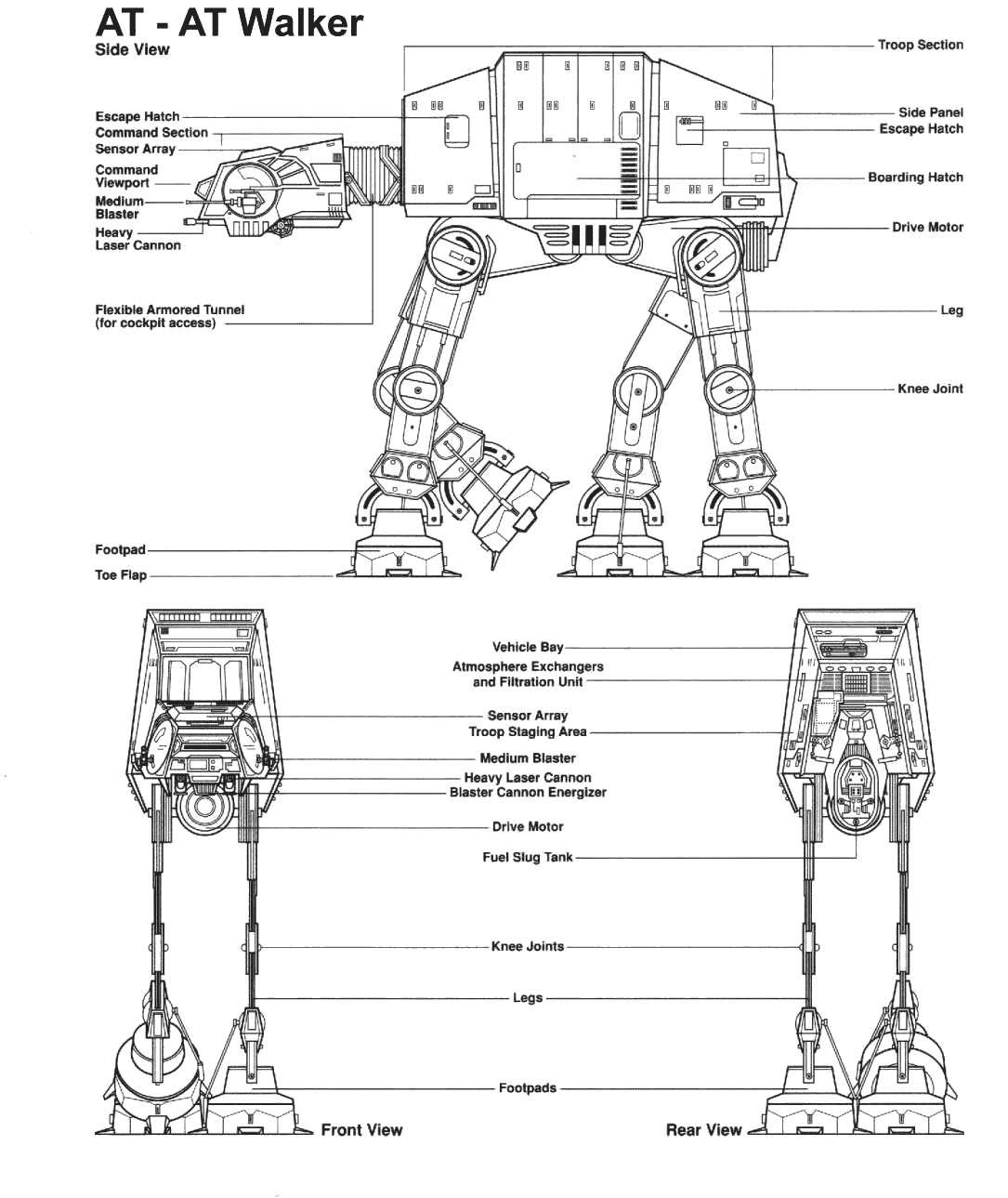
MEMBER ACCOUNT
EMPEROR'S HAMMER
TIE CORPS
OPERATIONS
- Battle Center
- Patch Archive
- Competition Center
- Combat Center
- Imperial University
- Mission Creation Center
- Fiction Center
DATA CENTER
- Killboards
- Squadron Battleboards
- Pilot Statistics and Ranks
- Medal Board
- Uniforms
- Roster Tools
- Complete Craft List
COMMUNICATIONS
EH SUBGROUPS
REFERENCE & MANUALS
- Encyclopaedia Imperia Wiki
- TIE Corps Pilot Manual
- SO Dark Side Compendium
- COO Manual
- Tactical Manual
- Fleet Manual
- Training Manual
- System Manual
- Fleet Order of Battle
EH POLICIES & INFO
UTC
Vehicle Course - Stage 4 Notes
Introduction
The All Terrain Armoured Transport (AT-AT)
Welcome to the big time trooper. This is it, the All Terrain Armoured Transport (AT-AT) Walker.
Specifications
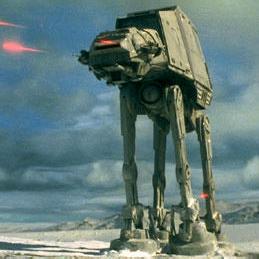 Name/Model: All Terrain Armoured Transport (AT-AT)
Name/Model: All Terrain Armoured Transport (AT-AT)
Designer/Manufacturer: Originally assembled by Kuat Drive Yards. Hammer’s Fist AT-AT’s assembled on Carrida II.
Combat Designation: Armoured Transport/Heavy Assault Vehicle
Scale of Vehicle: Walker
Height: 23.0 Metres
Length: 26.0 Metres
Crew: 5 (Commander, Pilot, Co-Pilot, Upper Deck Officer and Lower Deck Officer)
Skeleton Crew: 3
Troops: 40 Troops and 5 Speeder Bikes Or 2 AT-STs
Cargo Capacity: 1 Metric Ton
Weapons:
2 Chin Mounted Class II Heavy Laser Cannons (Fire-Linked)
2 Side Cockpit Mounted Medium Blaster Cannons (Fire-Linked) [Steerable and can be independent]
Maximum Speed: 60 kph (On flat, stable terrain)
The AT-AT is one of the most powerful surface vehicles to ever be constructed and not to mention, one of the largest. The AT-AT was designed to be used on any terrain on many different worlds and to match terror inspired by Imperial Star Destroyers and Stormtroopers. The Empire has countless repulsor vehicles, however the drive systems of these vehicles could be overcome by gravity fluctuations, unusual planetary magnetic fields, and or other special planetary conditions. Designers turned to older technology that was limited in use in older vehicle designs, such as the AT-PT. The walker designs were previously (in the Old Republic) not used on a large scale. At first, Imperial officers ridiculed the AT-AT, but their laughing came to an end when these mighty weapons of war proved themselves on the battlefield and surpassed Imperial expectations. Virtually unstoppable as weapons of war, they were impervious to all but heavy artillery weapons. Blaster bolts from ordinary turrets and cannons merely glance off the armour or are harmlessly absorbed and dissipated by it. Thus meaning it's armour is virtually impervious to blaster fire. A repeated concussion missile assault will penetrate the armour, however. AT-ATs proved to be potent and powerful psychological weapons due to their colossal size and their nightmarish animal resemblance combined with its combat strengths.
These walkers formed the core of many heavy ground assault units, often the first vehicles to leave their transports to enter in combat. In combat they can crush and strike fear in defending armies and even the most battle hardened troops fear the AT-AT. These metal monsters can crush anything and everything that is in their path with its massive durasteel feet. The stomping footpads of the AT-AT can cause the ground to shake before they even appear to the enemy, thus frightening and demoralizing the enemy. Until the Battle of Hoth, no army had ever fought resolutely against an onslaught of AT-ATs. A powerful reactor produces the raw energy needed to move this weighty walker. These walkers are capable of marching through most defences. The height of the vehicle allows the crew to view over obstacles that would interfere with other smaller combat vehicles, such as trees or low buildings that would be encountered during urban battle situations.
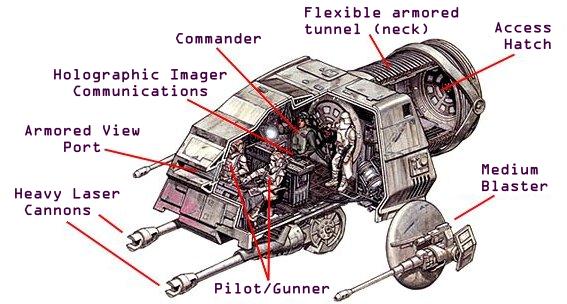 The head section holds all of the weapons and contains the command cockpit for the crew. Holographic Targeting Systems assist the gunner with a 360-degree view of the battlefield. These battlescan images can be viewed by the electro-rangefinder (pull-down periscope) or it can be superimposed upon the view port. The head section can rotate 30-degree arcs vertically and 90 degree arcs horizontally. The Pilot and the Gunner (Co-Pilot) can peer over the battlefield through the transparisteel view port and are supported by many sensory and targeting devices on board, thus providing the pilots a superior view of the battlefield around them. Both pilots are fully qualified to perform all control functions, in normal practice one serves as the driver, while the other serves as the gunner. Firing controls at any time can be yielded to the vehicle commander who stands at the combat co-ordination station, which is behind the pilot stations. The pilots are guided by terrain sensors located under the cockpit and terrain scanners and impulse terrain sensors built into the feet of the walker. The scans read the nature of the terrain ahead, assuring infallible footing. An armoured flexible tube connects the head section to the body, it acts just like a neck. The neck consists of ringed electromagnetic systems which enable the neck to flex.
The head section holds all of the weapons and contains the command cockpit for the crew. Holographic Targeting Systems assist the gunner with a 360-degree view of the battlefield. These battlescan images can be viewed by the electro-rangefinder (pull-down periscope) or it can be superimposed upon the view port. The head section can rotate 30-degree arcs vertically and 90 degree arcs horizontally. The Pilot and the Gunner (Co-Pilot) can peer over the battlefield through the transparisteel view port and are supported by many sensory and targeting devices on board, thus providing the pilots a superior view of the battlefield around them. Both pilots are fully qualified to perform all control functions, in normal practice one serves as the driver, while the other serves as the gunner. Firing controls at any time can be yielded to the vehicle commander who stands at the combat co-ordination station, which is behind the pilot stations. The pilots are guided by terrain sensors located under the cockpit and terrain scanners and impulse terrain sensors built into the feet of the walker. The scans read the nature of the terrain ahead, assuring infallible footing. An armoured flexible tube connects the head section to the body, it acts just like a neck. The neck consists of ringed electromagnetic systems which enable the neck to flex.
Beneath the main body are two immense drive motors that propel this metal beast. The side hatches on the main body are Escape Hatches, so if there is an emergency, personnel can get out of the walker. Those hatches are also used for access to the walker via boarding ramps of Imperial Landing Platforms.
Deployment
The Y-85 Titan dropship, more commonly known as the "walker dropship", is an important dropship used to deploy AT-ATs, prefabricated garrison bases and AT-STs onto planetary surfaces.
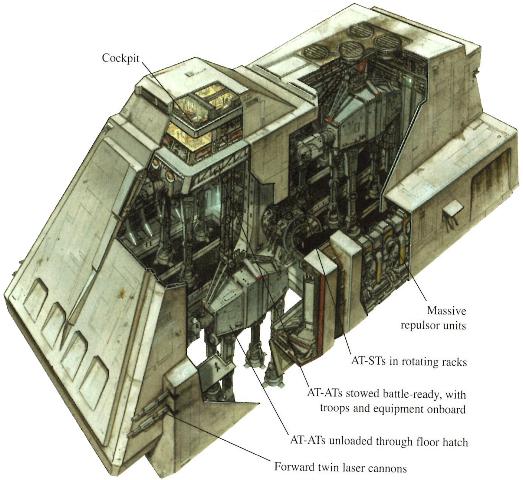
The Y-85 can accommodate four AT-ATs in addition to four AT-STs. Walkers are held by cranes, clamped along the sides, in battle-ready configuration, and can be quickly deployed via drop-down floor hatches. The Y-85 is armed with two forward twin laser cannons for defense.
Motion
During the normal walking motion of an AT-AT, only one foot moves at a time. On flat terrain, the steps are taken in a regular sequence. When the walker is moving straight ahead, all the steps are the same length. When the walker turns or traverses uneven terrain, the step sizes vary.
The top speed of an AT-AT is said to be about 60km/hr or 17m/s. At this pace the vehicle would advance by its own body length in 1.6 seconds. This is not an unreasonable level of activity considering the length of the walker's stride and the effectiveness of power sources in STAR WARS technology. If the stride of an AT-AT is about ten metres, Each foot would make a step every 0.6s during a drive at maximum speed. If only one leg moves at a time, each entire step would have to start and finish within 0.15s. It seems most likely that a running AT-AT steps with more than one foot at a time. It is most likely that the diagonally opposite feet would move synchronously.
Capacity
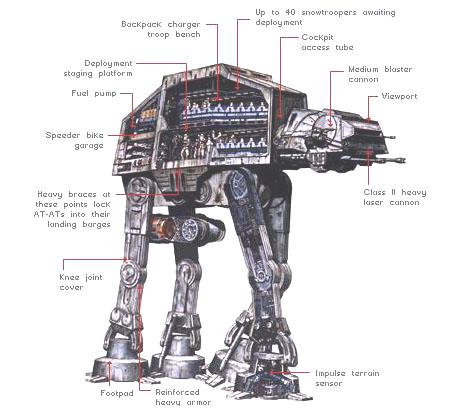 AT-AT walkers carry forty ground troops plus five speeder bikes and alternative interior fit allows an AT-AT to carry two scout walkers, which must be partially disassembled.
AT-AT walkers carry forty ground troops plus five speeder bikes and alternative interior fit allows an AT-AT to carry two scout walkers, which must be partially disassembled.
AT-AT walkers are can deploy their passengers via several different means. They can kneel to within three metres of the ground for the troops to debark via side hatches. Many people believe that AT-AT walkers have rear hatches, however the hind section of an AT-AT is consists of solid drive mechanisms connected to the cylindrical belly shaft and therefore it is not possible to have access hatches at the rear.
AT-AT walkers have two internal decks, troops riding in the body section deploy through one or more belly or side hatches. They can abseil down cables that can be lowered from theses hatches that means troops can be disgorged quickly and also spares them and the walker from vulnerability since it can occur while the machine is upright. This form of deployment takes precedence over the kneeling method, which is only acceptable in pacified zones.
One major role of the AT-AT is that it is intended for active, long-term, independent patrols. This is the main reason for the baseline troop capacity of forty Stormtroopers as they often need to devote considerable internal space to the platoon's supplies. The AT-AT has considerable internal space and in its shock assault role can carry far more personnel.
AT-ATs usually carries a set of speeder bikes for scouting or survivor-hunting missions. The speed and agility of the speeder bikes complement the walkers, making the combined assault capability thorough and overwhelming. The AT-ATs used at the glorious Battle of Hoth were specially modified cold-weather AT-ATs. While they have the all the outside appearances of an ordinary AT-AT, these walkers had specially designed heat circulation systems, de-icing controls and energy efficient environmental controls. However, ordinary AT-ATs perform well in desert, forest or snow conditions.
Weaponry
The AT-AT has two pairs of guns, mounted on the chin and the cheeks. The heavier cannons on the chins are fixed to point in the direction of the walker's head. They therefore have more physical support, and they seem to need it. Due to some kind of recoil or another reason, the guns jerk backwards be at least half a metre when they are fired. They swing back into their normal position within less than a second. The entire lower part of the walker's head looks as if it is dedicated to suspension and power for these cannons.
The side guns are on vertical turrets, allowing them to swivel upwards to fire upon targets above the walker. This makes the guns better suited to defending the AT-AT against hostile craft in the air. The heavy chin guns, in contrast, seem suited to obliterating slow-moving targets on the ground.
Armour
AT-AT walkers are essentially invulnerable to conventional artillery fire. Their hull surfaces absorb and dissipate blaster bolts without the vehicle feeling so much as a jolt. However, concussion missiles or proton torpedoes can easily overcome their armour.
The effectiveness of the armour of AT-AT walkers is directional. It is astonishingly resilient to enemy fire from the outside, but is easily demolished from within. However, this is not normally a problem as it is almost impossible for an attacker to gain access to the interior of an AT-AT walker to carry out any form of sabotage.
Only three main points of vulnerability in the AT-AT hull are known at this time. The first is the pair of open vents just under the armoured upper shelf of the front face of the main hull while the second is that they can be tripped up by entangling their legs as the rebellion did on Hoth. The third problem is that the neck section, which carries many vital linkages, is vulnerable to repeated attack.
